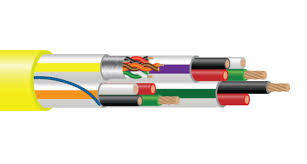views
The low voltage cable market plays a foundational role in the global electrical infrastructure landscape. It encompasses a wide range of applications across power distribution, telecommunications, industrial machinery, consumer electronics, and building automation. With growing urbanization, technological advancements, and an increasing emphasis on renewable energy and smart grids, the scope of the low voltage cable market is rapidly expanding. This article explores the key drivers, emerging sectors, application areas, and geographical trends that are defining the broad and evolving scope of this dynamic market.

Definition and Importance
Low voltage cables are defined as electrical cables designed to carry voltages below 1,000 volts. They are essential for distributing electricity safely and efficiently from substations to end-users, and for connecting various systems and components within residential, commercial, and industrial infrastructures. Their importance lies in their versatility, safety, and reliability in managing energy at low voltages while ensuring compliance with electrical standards.
These cables are manufactured using copper or aluminum conductors with insulation and sheathing made of PVC, XLPE, or other materials, depending on the application. As building codes and industry standards evolve, so do the designs and specifications of these cables to meet safety, durability, and energy-efficiency criteria.
Key Application Areas
The scope of the low voltage cable market stretches across several core application domains:
-
Residential Sector: Wiring for lighting, outlets, and internal circuits forms the bulk of cable demand in this segment. Urban housing developments and smart home installations are significantly driving growth.
-
Commercial Buildings: Office complexes, malls, hospitals, and data centers require extensive low voltage cabling for lighting, HVAC systems, fire alarms, security, and IT networking.
-
Industrial Sector: Manufacturing plants, mining operations, and oil & gas facilities utilize low voltage cables for machinery, control panels, and process automation.
-
Infrastructure and Utilities: Cables are critical for low voltage power distribution in airports, metro systems, railways, and government buildings.
-
Renewable Energy Projects: As solar and wind power plants expand, low voltage cables are used to connect inverters, control panels, and monitoring systems.
-
Automotive and EV Charging: Electric vehicles (EVs) and their charging infrastructure rely heavily on flexible, durable, and high-performance low voltage cabling solutions.
Market Drivers Enhancing Scope
Several macro and microeconomic factors are broadening the scope of the low voltage cable market:
-
Urbanization and Infrastructure Development: Rapid urban expansion in Asia-Pacific, Africa, and Latin America increases the demand for housing, utilities, and transportation systems—all of which require robust low voltage cable networks.
-
Energy Transition and Electrification: The global shift towards electrification, especially in heating and transportation, is driving more widespread use of low voltage cabling.
-
Smart Grid and Building Automation: Smart systems require integrated cabling for sensors, controllers, and communication devices—creating demand for advanced and IoT-compatible low voltage cables.
-
Renewable Energy Integration: Wind farms and solar installations need reliable cabling to support grid connectivity and energy storage systems.
-
Government Regulations and Electrification Policies: Public sector initiatives focused on expanding electricity access in rural areas and decarbonizing energy systems further support the expansion of the low voltage cable market.
Emerging Trends Expanding Market Scope
-
Green and Halogen-Free Cables: Increasing environmental regulations are pushing manufacturers to develop cables that are recyclable, non-toxic, and fire-retardant, opening new market niches.
-
Modular Construction: Prefabricated buildings require plug-and-play wiring solutions, leading to demand for factory-assembled, pre-tested low voltage cables.
-
Digital Twins and Smart Monitoring: Cables integrated with sensors for real-time monitoring and predictive maintenance are becoming mainstream, particularly in critical infrastructure and industrial automation.
-
Miniaturization and Flexibility: Compact, flexible cables are in demand for modern architecture, tight installation spaces, and portable devices.
-
Telecom and Data Cabling: The rise in data consumption and fiber optics integration expands the market’s scope into hybrid copper-fiber low voltage solutions.
Geographic Expansion and Opportunities
The geographic scope of the low voltage cable market is also widening:
-
Asia-Pacific remains the largest and fastest-growing region due to rapid industrialization, construction boom, and government electrification drives.
-
North America is driven by energy-efficient building retrofits, smart city programs, and renewable integration.
-
Europe focuses on sustainable cabling solutions and high-end automation in commercial and industrial sectors.
-
Middle East & Africa offer potential due to ongoing infrastructure development and large-scale power projects.
-
Latin America is experiencing growth in public housing and energy reforms, boosting low voltage cable demand.
Challenges That May Limit Scope
Despite growing opportunities, certain challenges could restrain the market’s full potential:
-
Volatility in Raw Material Prices: Fluctuations in copper and polymer costs may hinder consistent product availability and pricing.
-
Counterfeit and Substandard Products: In unregulated markets, the prevalence of low-quality products affects brand reputation and safety.
-
Lack of Skilled Labor: Proper installation and handling of low voltage cables require trained electricians, which are in short supply in some regions.
-
Fragmented Supply Chains: Inconsistent distribution networks and logistics issues can impact timely delivery and customer satisfaction.
Conclusion
The scope of the low voltage cable market is vast and expanding as the world moves toward electrification, digital infrastructure, and sustainable energy solutions. With diverse applications spanning residential, industrial, and renewable sectors, the market holds significant potential for manufacturers and investors alike. By addressing emerging trends, regulatory changes, and technological demands, stakeholders can position themselves to capitalize on this evolving and essential market. Continued innovation and strategic planning will be key to unlocking further growth and extending the reach of low voltage cable solutions globally.



Comments
0 comment